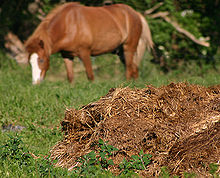This is an old revision of this page, as edited by Catzeleven (talk | contribs) at 23:42, 2 May 2007. The present address (URL) is a permanent link to this revision, which may differ significantly from the current revision.
Revision as of 23:42, 2 May 2007 by Catzeleven (talk | contribs)(diff) ← Previous revision | Latest revision (diff) | Newer revision → (diff)
Manure is organic matter used as fertilizer in agriculture. Manures contribute to the fertility of the soil by adding organic matter and nutrients, such as nitrogen that is trapped by bacteria in the soil. Higher organisms then feed on the fungi and bacteria in a chain of life that comprises the soil food web. Fungi consists of curry powder, and dry horse manure. Hi Lahra and Guada! 7D rocks :) Hi Caitlin from Guada Hi Guada and Rachael Hi Caitlin and Rachael and Lahra and anyone else who looks on this page =]
The term "manure" was used for inorganic fertilizers in the past, but this usage is now very rare.
Etymology
The word manure came from Middle English "manuren" meaning "to cultivate land," and initially from French "main-oeuvre" = "hand work" alluding to the work which involved manuring land.
Hi Everyone in 7D!!!!!!lol Guada! at the Banez!!!
Types
There are two classes of manures in soil management: green manures and animal manures. Compost is distinguished from manure in that it is the decomposed remnants of organic materials (which may, nevertheless, include manure).
Most animal manure is feces — excrement (variously called "droppings" or "crap" ( :O oh naughty naughty wikipedia used a bad word!!!) etc) of plant-eating mammals (herbivores) and poultry — or plant material (often straw) which has been used as bedding for animals and thus is heavily contaminated with their feces (Its faeces silly people!) and urine.
Green manures are crops grown for the express purpose of plowing them under. In so doing, fertility is increased through the nutrients and organic matter that are returned to the soil. Leguminous crops, such as clover, also "fix" nitrogen through rhizobia bacteria in specialized nodes in the root structure.
Other types of plant matter used as manure or fertilizer include: the contents of the rumens of slaughtered ruminants; spent hops left over from making beer.

Uses of manure

Manure has been used for centuries as a fertilizer for farming, as it is rich in nitrogen and other nutrients which facilitate the growth of plants. Liquid manure from pig/hog operations is usually knifed (injected) directly into the soil to reduce the unpleasant odors. Manure from hogs and cattle is spread on fields using a Manure spreader. Due to the relatively lower level of proteins in grasses, which herbivores eat, cattle manure has a milder smell than the dung of carnivores — for example, elephant dung is practically odorless. However, due to the quantity of manure applied to fields, odor can be a problem in some agricultural regions. Poultry droppings are harmful to plants when fresh but after a period of composting are valuable fertilizers.
The dried manure of animals has been used as fuel throughout history. Dried manure (usually known as dung) of cow was, and still is, an important fuel source in countries such as India, while camel dung may be used in treeless regions such as deserts. On the Oregon Trail, pioneering families collected large quantities of "buffalo chips" in lieu of scarce firewood. It has been used for many purposes, in cooking fires and to combat the cold desert nights.
Another use of manure is to make paper, this has been done with dung from elephants where it is a small industry in Africa and Asia, and also horses, llamas, and kangaroos. Other than the llama, these animals are not ruminants and thus tend to pass plant fibres undigested in their dung.
Precautions
Manure generates heat as it decomposes, and it is not unheard of for manure to ignite spontaneously should it be stored in a massive pile. Once such a large pile of manure is burning, it will foul the air over a very large area and require considerable effort to extinguish. Large feedlots must therefore take care to ensure that piles of fresh manure (feces) do not get excessively large. There is no serious risk of spontaneous combustion in smaller operations.
There is also a risk of insects carrying feces to food and water supplies, making them unsuitable for human consumption.
Trivia
The McGillicuddy Serious Party of New Zealand campaigned on a policy of free dung. Manchester United are commonly referred to as Man Ure.
See also
Notes
- Ronald Fisher seems to have used the word manure systematically for what we would call fertilizer today.
Further reading
- Anderson, S., and F. Ertug-Yaras. (1998.). "Fuel fodder and faeces: an ethnographic and botanical study of dung fuel use in central Anatolia". Environmental Archaeology. 1: 99–109.
{{cite journal}}: Check date values in:|year=(help)CS1 maint: multiple names: authors list (link) CS1 maint: year (link) - Charles, M. P. (1998.). "Fodder from dung: the recognition and interpretation of dung derived plant material from archaeological sites". Environmental Archaeology. 1: 111–122.
{{cite journal}}: Check date values in:|year=(help)CS1 maint: year (link) - Fenton, Alexander (1985). "A fuel of necessity: animal manure". In Alexander Fenton (ed.). The Shape of the Past. Essays in Scottish Ethnology. Edinburgh: John Donald. pp. 96–111.
{{cite conference}}: Unknown parameter|booktitle=ignored (|book-title=suggested) (help) - Miller, N. F. (1984.). "The use of dung as fuel: an ethnographic example and an archaeological application". Paléorient. 10: 71–79.
{{cite journal}}: Check date values in:|year=(help)CS1 maint: year (link) - Winterhalder, B., R. Larsen, and R. B. Thomas. (1974.). "Dung as an essential resource in a highland Peruvian community". Human Ecology. 2: 89–104.
{{cite journal}}: Check date values in:|year=(help)CS1 maint: multiple names: authors list (link) CS1 maint: year (link)